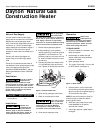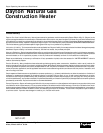
Dayton Operating Instructions and Parts Manual
2
Dayton Natural Gas
Construction Heater
®
3VH19
General Safety Information
Make certain you read and understand all
warnings. Keep these instructions for
reference. It is your guide to safe and
proper operation of this heater.
Safety information appears throughout
these instructions. Pay close attention to
them. Below are definitions for the safety
information listed throughout this manual.
Under this heading,
installation, operat-
ing and maintenance procedures or
practices will be found that, if not carefully
followed, WILL result in IMMEDIATE
serious personal injury or death.
Under this heading,
installation, operat-
ing, and maintenance procedures or
practices will be found that, if not
carefully followed, COULD result in severe
personal injury or death.
Under this heading,
installation, operat-
ing, and maintenance procedures or
practices will be found that, if not carefully
followed, MAY result in minor personal
injury, product or property damage.
IMPORTANT: Every possible circumstance
that might involve a hazard cannot be
anticipated. The warnings in this manual
and on tags or decals affixed to the unit
are therefore not all-inclusive. If a proce-
dure, work method, or operating tech-
nique not specifically recommended by
Dayton is used, you must make sure it is
safe for you and others. You should also
ensure that equipment will not be
damaged or made unsafe by the operating
or maintenance method you choose.
Carbon monoxide
poisoning: Some
people are more affected by carbon
monoxide than others. Early signs of
carbon monoxide poisoning resemble
the flu, with headaches, dizziness,
and/or nausea. If you have these signs,
the heater may not be operating
properly. Get fresh air at once! Have
heater serviced.
Natural Gas: Natural gas has a distinc-
tive odor. This odor helps you detect a
natural gas leak. However, the odor
may fade. Natural gas may be present
even though no odor exists.
• Install and use
heater with care.
Follow all local ordinances and
codes. In the absence of local
ordinances and codes, refer to the
National Fuel Gas Code Handbook,
NFPA54/ANSI Z223.1 and the Natural
Gas Installation Code, CAN/CGA
B149.2. This instructs on the safe
storage and handling of flammable
gases.
• Use only with natural gas. Do NOT
attempt to use with LP gas.
• Provide adequate ventilation. Before
using heater, provide at least a
three-square-foot opening of fresh,
outside air for each 100,000 Btu/Hr of
rating. This heater produces carbon
monoxide, which is listed by the
State of California as a reproductive
toxin under Proposition 65.
• For indoor use only. Do NOT use
heater outdoors.
• Do NOT use heater in occupied
dwellings or in living or sleeping
quarters.
• Do NOT use heater below ground
level.
• Keep appliance area clear and free
from combustible materials, gaso-
line, paint thinner, and other flam-
mable vapors and liquids. Do NOT
use heater in areas with high dust
content.
• Minimum heater clearances from
combustible materials:
Sides: 6 Ft. Top: 5 Ft.
• Check heater for damage before each
use. Do NOT use a damaged heater.
• Check hose (if used) before each use
of heater. If highly worn or cut,
replace before using heater.
• Locate heater on stable and level
surface if heater is hot or operating.
• Not intended for use on finished
floors.
• Never block air inlet (bottom of
shell) or air outlet (top of shell) of
heater.
• Keep heater away from strong
drafts, water spray, rain, or dripping
water.
• Keep children and animals away
from heater.
• Do NOT leave heater unattended.
• Never move, handle, or service a hot
or operating heater. Severe burns
may result. You must wait 20
minutes after turning heater off.
• To prevent injury, wear gloves when
handling heater.
• Never attach duct work to heater.
• Do NOT alter heater. Keep heater in
its original state.
• Do NOT use heater if altered.
• Turn off natural gas supply to heater
when NOT in use.
• Use only original replacement parts.
This heater must use design-specific
parts. Do NOT substitute or use
generic parts. Improper replacement
parts could cause serious or fatal
injuries.














